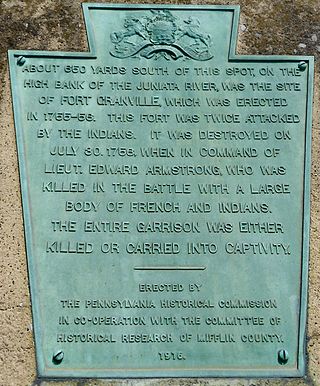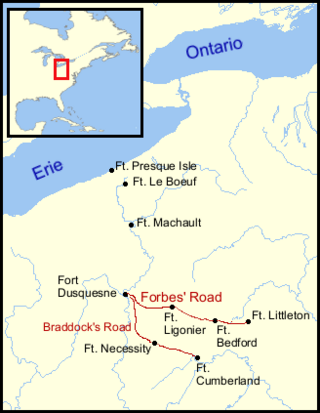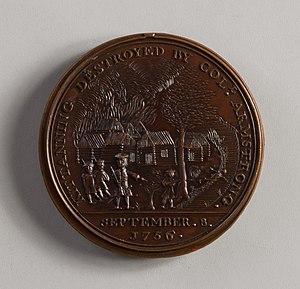
Armstrong County is a county in the Commonwealth of Pennsylvania. As of the 2020 census, the population was 65,558. The county seat is Kittanning. The county was organized on March 12, 1800, from parts of Allegheny, Westmoreland and Lycoming Counties. It was named in honor of John Armstrong, who represented Pennsylvania in the Continental Congress and served as a major general during the Revolutionary War.

The Kittanning Path was a major east-west Native American trail that crossed the Allegheny Mountains barrier ridge connecting the Susquehanna River valleys in the center of Pennsylvania to the highlands of the Appalachian Plateau and thence to the western lands beyond drained by the Ohio River. Kittanning Village was the first major Delaware (Lenape) Indian settlement along the descent from the Allegheny Plateau.

Kittanning was an 18th-century Native American village in the Ohio Country, located on the Allegheny River at present-day Kittanning, Pennsylvania. The village was at the western terminus of the Kittanning Path, an Indian trail that provided a route across the Alleghenies between the Ohio and Susquehanna river basins.
Shingas was a Lenape chief and warrior who participated in military activities in Ohio Country during the French and Indian War. Allied with the French, Shingas led numerous raids on Anglo-American settlements during the war, for which he was nicknamed "Shingas the Terrible" by the settlers. The colonial governments of Pennsylvania and Virginia responded to these raids by placing a bounty on Shingas.

Fort Loudoun was a fort in colonial Pennsylvania, one of several forts in colonial America named after John Campbell, 4th Earl of Loudoun. The fort was built in 1756 during the French and Indian War by the Second Battalion of the Pennsylvania Regiment under Colonel John Armstrong, and served as a post on the Forbes Road during the Forbes expedition that successfully drove the French away from Fort Duquesne. The fort remained occupied through Pontiac's War and served as a base for Colonel Henry Bouquet's 1764 campaign. In the 1765 Black Boys Rebellion, Fort Loudoun was assaulted by angry settlers, when their guns were confiscated after they destroyed supplies intended for Native Americans. The garrison retreated to Fort Bedford and the fort was abandoned.
Tewea, better known by his English name Captain Jacobs, was a Lenape chief during the French and Indian War. Jacobs received his English name from a Pennsylvanian settler named Arthur Buchanan, who thought the chief resembled a "burly German in Cumberland County."
The Battle of Sideling Hill was an engagement in April 1756, between Pennsylvania Colonial Militia and a band of Lenape warriors who had attacked Fort McCord and taken a number of colonial settlers captive. The warriors were taking their captives back to their base at Kittanning when they were ambushed by the militia, but with the help of reinforcements, the Lenape fought off the militia and escaped. The battle is significant because it was the first engagement involving Pennsylvania Militia after Braddock's defeat.

Fort Granville was a militia stockade located in the colonial Province of Pennsylvania. Its site was about a mile from Lewistown, in what is now Granville Township, Mifflin County. Active from 1755 until 1756, the stockade briefly sheltered pioneer settlers in the Juniata River valley during the French and Indian War. The fort was attacked on August 2, 1756, by a mixed force of French troops and Native Americans, mostly Lenape warriors. The fort’s garrison surrendered the strongpoint to these attackers, who celebrated their victory and destroyed the stockade.

Fort Shirley was a military fort located in present-day Shirleysburg, Pennsylvania. It was built in 1755 by George Croghan and later maintained by the Province of Pennsylvania during the French and Indian War. Fort Shirley was part of a defensive line of forts built in Pennsylvania during 1755 and 1756, at the start of hostilities with the French and their allied Native Americans. Although two French and Native American war parties were sent to capture it, Fort Shirley was never attacked. The fort served as the launching site for the Kittanning Expedition in September 1756, after which it was abandoned.

The Penn's Creek massacre was an October 16, 1755 raid by Lenape (Delaware) Native Americans on a settlement along Penn's Creek, a tributary of the Susquehanna River in central Pennsylvania. It was the first of a series of deadly raids on Pennsylvania settlements by Native Americans allied with the French in the French and Indian War.

Kuskusky, also known as the Kuskuskies Towns, Kuskuskie Towns, or Kuskuskies' Indian Town, with a wide variety of other spellings, were several Native American communities inhabited near New Castle, Mahoning, and Edinburg, Pennsylvania, and Youngstown, Ohio, during the mid-18th century. It was not one town, but three or four contiguous towns of the Mingoes, Lenape, and Seneca, located along the Beaver River, at and above the junction of its east and west branches, the Mahoning River and the Shenango River. It is usually referred to in the plural.

Muskingum was a Wyandot village in southeastern Ohio from 1747 to 1755. It was an important trade center in the early 1750s, until it was devastated by smallpox in the winter of 1752. The town was repopulated for a short time afterwards, then abandoned again as a new community was established by Netawatwees a few miles to the east at Gekelukpechink. The city of Coshocton, Ohio was founded close to the site of the village in 1802.

Saucunk or Sawcunk was a town established by the Lenape and Shawnees. It was the site of a Catholic mission and was visited by Conrad Weiser, Christian Frederick Post and George Croghan. The Lenape chiefs Tamaqua, Pisquetomen, Captain Jacobs and Shingas all lived there temporarily. Saucunk was abandoned after the Battle of Bushy Run in 1763.
Pisquetomen was a Lenape chief who acted as interpreter and negotiator for the Lenape in dealings with the Provincial government of Pennsylvania during the mid-eighteenth century. After being rejected in his bid to succeed his uncle Sassoonan as Lenape chief, Pisquetomen joined Shingas and Captain Jacobs in a series of deadly attacks on Pennsylvania settlements at the beginning of the French and Indian War. He eventually participated in peace negotiations that led to the Treaty of Easton in 1758, and is believed to have died in 1762.

Tamaqua or Tamaque, also known as The Beaver and King Beaver, was a leading man of the Unalachtigo (Turkey) phratry of the Lenape people. Although the Iroquois in 1752 had appointed Shingas chief of the Lenape at the Treaty of Logstown, after the French and Indian War Tamaqua rose in prominence through his active role as peace negotiator, and was acknowledged by many Lenape as their "king" or chief spokesman. He was among the first to hand over English captives at the end of the French and Indian War and was active in peace negotiations at the conclusion of Pontiac's War. By 1758, he was recognized as one of three principal leaders of the Lenape, being the primary spokesman for the western Lenape in the Ohio Country. He founded the town of Tuscarawas, Ohio, in 1756 and died there in 1769 or 1771.

Shannopin's Town, or Shannopintown, was an 18th-century Lenape (Delaware) town located within the site of modern-day Pittsburgh, Pennsylvania, along the Allegheny River, approximately two miles east from its junction with the Monongahela River. In the early 1700s, British colonial settlers began spreading into western Pennsylvania, forcing Lenape and other American Indian tribes to move further west, settling in the Ohio Country. Shannopin's Town was one of several communities established in western Pennsylvania in the 1720s. The town was largely abandoned during the construction of Fort Duquesne in 1754, although a small community still existed when General John Forbes' troops arrived in September 1758. The community was gone by the time construction on Fort Pitt was started in 1759.
Keekyuscung aka Kickyuscung, Kaquehuston, Kikyuskung, Ketiuscund, Kekeuscund, or Ketiushund, was a Delaware (Lenape) chief. In the 1750s he took part in peace negotiations to end Lenape participation in the French and Indian War. In 1754 he briefly engaged in some spying and smuggled some letters into and out of Fort Duquesne for George Washington. He was sympathetic to the British for many years, but in 1763 he and his son Wolf sided with the French after a failed assassination attempt by Colonel Henry Bouquet. He is known for being one of the Native American leaders that attacked Colonel Bouquet's forces at the Battle of Bushy Run, where Keekyuscung was killed.
Hugh Gibson was an American pioneer and a Pennsylvania frontiersman. In 1756, when he was 14 years old, his farm was attacked by Lenape Indians and he was taken prisoner. He was adopted as a brother by Pisquetomen, a Lenape chief, and lived for three years with the Lenape, moving to several different communities. In 1759 he escaped, together with three other captives.

Fort Lyttleton, also known as Fort Littleton, was a militia stockade located in the colonial Province of Pennsylvania. Its site was about a mile from Fort Littleton, Pennsylvania, near Dublin Township, in what is now Fulton County, Pennsylvania. Active from 1755 until 1763, the stockade was initially garrisoned by 75 Pennsylvania troops but at times had as many as 225. It was in use until 1759, then abandoned and reoccupied briefly in 1763 during Pontiac's War.

The Great Cove massacre was an attack by Shawnee and Lenape warriors led by Shingas, on the community of Great Cove, Pennsylvania on 1 November 1755, in which about 50 settlers were killed or captured. Following the attack, settlers returned to the community to rebuild, and the Provincial Council of Pennsylvania began constructing a chain of forts and blockhouses to protect settlers and fend off further raids. These forts provided an important defense during the French and Indian War.















